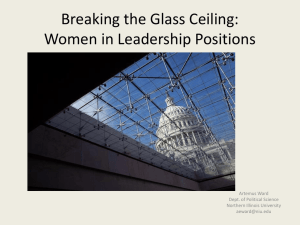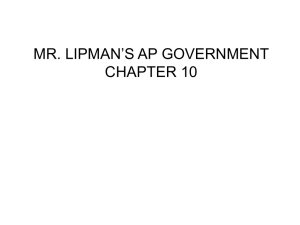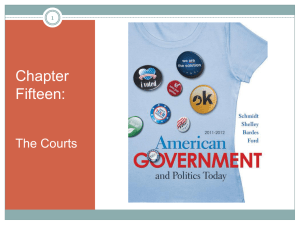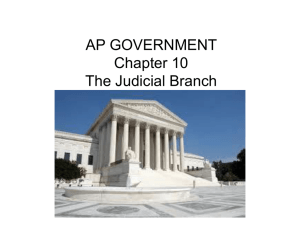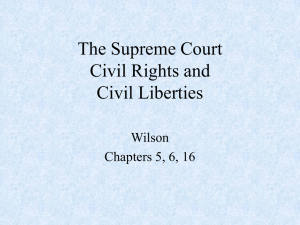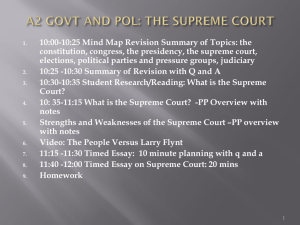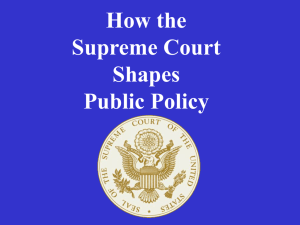The Supreme Court - Perris Union High School District
advertisement
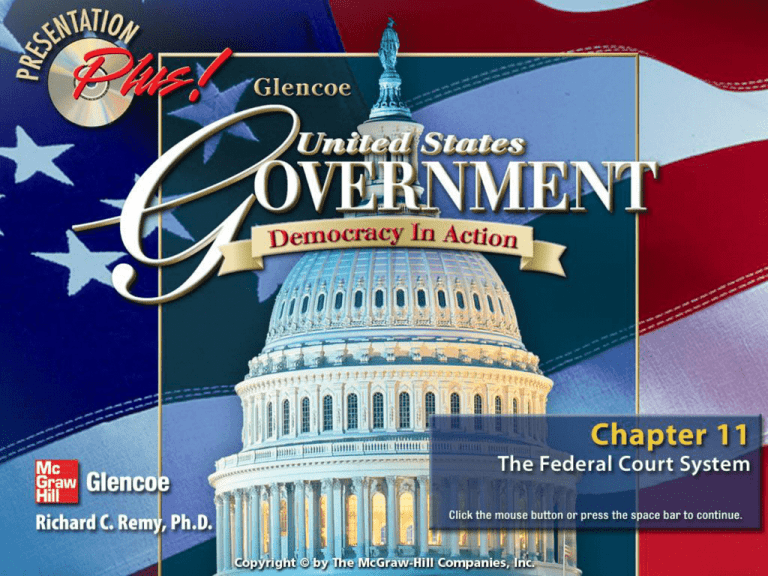
Chapter 11: The Federal Court System Chapter Focus Section 1 Powers of the Federal Courts Section 2 Lower Federal Courts Section 3 The Supreme Court Chapter Assessment http://www.youtube.com/watch?feature=endscreen&NR=1&v=HTVvZ1Sdkaw Chapter Objectives • Powers of the Federal Courts Compare the jurisdiction of federal and state courts and describe the growth of the Supreme Court. • Lower Federal Courts Explain the jurisdiction of constitutional and legislative courts and the method of selecting federal judges. • The Supreme Court Describe the jurisdiction of the Supreme Court, the duties of its justices, and the way its justices are selected. Powers of the Federal Courts Key Terms concurrent jurisdiction, original jurisdiction, appellate jurisdiction, litigant, due process clause Find Out • How does federal court jurisdiction differ from state court jurisdiction? • How do Supreme Court decisions reflect the attempts of the justices to meet changing social conditions? Powers of the Federal Courts Understanding Concepts Constitutional Interpretations How has the Supreme Court historically increased its power? Section Objective Compare the jurisdiction of federal and state courts and describe the growth of the Supreme Court. By the twentieth century, the Supreme Court had become so powerful that Chief Justice Charles Evans Hughes once boasted: “We are under a Constitution, but the Constitution is what the judges say it is.” Justice Hughes served on the Court from 1930 to 1941; during that time the justices did, in fact, strike down many New Deal measures as unconstitutional. I. Jurisdiction of the Courts (pages 305–307) A. The United States has a dual court system of state and federal courts. B. State courts have jurisdiction over cases involving state laws. C. Federal courts have jurisdiction over cases involving United States laws, foreign treaties, and the interpretation of the Constitution. D. In some cases, federal and state courts have concurrent jurisdiction. E. In the federal court system, trial courts are district courts that have original jurisdiction; federal courts of appeals have only appellate jurisdiction, or authority to hear cases appealed from district courts. I. Jurisdiction of the Courts (pages 305–307) I. Jurisdiction of the Courts (pages 305–307) Compare the jurisdictions of state courts and federal courts. State courts have jurisdiction over cases involving state laws; federal courts over federal laws. II. Developing Supreme Court Power (pages 307–308) A. The Supreme Court has become the most powerful court in the world; its power developed from custom, usage, and history. B. No federal court, including the Supreme Court, may initiate action. C. Federal courts only determine cases; they never simply answer a legal question. D. Chief Justice Marshall’s ruling in Marbury v. Madison (1803) gave the Court power to review acts of Congress, or judicial review. II. Developing Supreme Court Power (pages 307–308) E. Marshall broadened federal power at the expense of the states. F. Justice Taney emphasized the rights of states and those of citizens. II. Developing Supreme Court Power (pages 307–308) Do you think the power of judicial review is more or less important today than it was during John Marshall’s time? Explain your reasoning. Answers will vary. Judicial review has expanded since Marshall’s time. Students may believe that judicial review is more important than ever because laws are more numerous and more complex. III. Due Process and Regulatory Power (pages 308–310) A. The Supreme Court’s rulings on the Reconstruction Amendments eventually applied these amendments to economic policy. B. In Plessy v. Ferguson (1896), the Court established the “separate but equal” precedent. C. In the Granger cases (1870s), the Court held that a state had the power to regulate railroads and other private property. III. Due Process and Regulatory Power (pages 308–310) D. After President Franklin D. Roosevelt’s Court-packing scheme of 1937 failed, the justices began to uphold laws regulating businesses. E. Under Chief Justice Earl Warren, the Supreme Court emerged as a major force in protecting civil rights, beginning with Brown v. Board of Education of Topeka (1954). III. Due Process and Regulatory Power (pages 308–310) How do you think the course of United States history might have been changed if the Court had ruled the opposite way in Plessy v. Ferguson? Answers will vary. Perhaps integration would have happened sooner. Checking for Understanding 1. Main Idea Use a graphic organizer like the one below to show how the Supreme Court extended civil liberties in the 1950s and 1960s. Effect/Cause: Brown v. Board of Education of Topeka, KS Effect: Outlawed segregation in public schools Checking for Understanding Match the term with the correct definition. ___ D concurrent jurisdiction ___ B original jurisdiction ___ E appellate jurisdiction A. states that no states may deprive a person of life, liberty, or property without due process of law B. the authority of a trial court to be first to hear a case C. a person engaged in a lawsuit ___ C litigant D. authority shared by both federal and state courts ___ A due process clause E. authority held by a court to hear a case that is appealed from lower court Checking for Understanding 3. Identify Marbury v. Madison, judicial review, “separate but equal” doctrine. Marbury v. Madison is the Supreme Court case that established judicial review. Judicial review is the Supreme Court’s power to review acts of Congress. The “separate but equal” doctrine evolved from the Supreme Court’s Plessy v. Ferguson which held that if facilities for both races were equal, they could be separate. Checking for Understanding 4. Identify the different jurisdictions of federal and state courts. State courts have jurisdiction over state laws; federal courts over U.S. laws, treaties, the Constitution, bankruptcy, and maritime laws. Checking for Understanding 5. What doctrine was established by the ruling in Plessy v. Ferguson? The “separate but equal” doctrine, which held that if facilities for both races were equal, they could be separate, was established by this ruling. Critical Thinking 6. Identifying Alternatives What choice of jurisdiction would be available to a person who was being sued by a citizen of another state for damages of at least $75,000? The person being sued could choose to have the case tried in the state court or in a federal court. Constitutional Interpretations Choose one of the cases discussed in Section 1 or another case that contributed to the development of the power of the Supreme Court. Research the details of the case, including the background, the ruling, and the reasons for the ruling. Write a newspaper article or tape a news broadcast announcing the effects of the ruling. Lower Federal Courts Key Terms grand jury, indictment, petit jury, judicial circuit, senatorial courtesy Find Out • How do constitutional courts and legislative courts differ in their jurisdiction? • How are federal court justices chosen? Lower Federal Courts Understanding Concepts Political Processes If federal judges are shielded from direct political influence, why do presidents try to appoint judges who share their views? Section Objective Explain the jurisdiction of constitutional and legislative courts and the method of selecting federal judges. Although presidents have the authority to select federal judges, Congress can block those selections. After his reelection in 1996, President Clinton had the authority to fill more than half of all federal district court and appeals court posts with his choices. The chairperson of the Senate Judiciary Subcommittee on Administrative Oversight and the Court, however, blocked action on confirming 92 judges Clinton had earlier nominated and held only a few hearings on many of the new jurists nominated by the president. I. Constitutional Courts (pages 312–314) A. The federal district courts were created by Congress as trial courts for both civil and criminal cases. B. In criminal cases, there are two types of juries: a grand jury, which hears charges against a person accused of a crime, and a petit jury, or trial jury, which weighs the evidence presented at trial. C. District courts carry the main burden in federal cases. D. In the vast majority of cases, district courts render the final decision. I. Constitutional Courts (pages 312–314) E. Many appointed officials provide services for district courts. F. The 13 courts of appeals ease the appellate workload of the Supreme Court. G. The courts of appeals may decide to uphold the original decision, reverse the decision, or send the case back to the original court to be tried again. H. The Court of International Trade hears cases dealing with tariffs. http://www.youtube.com/watch?v=ZS2Up5TeirM – Road to the U.S. Supreme Court I. Constitutional Courts (pages 312–314) I. Constitutional Courts (pages 312–314) Compare the duties of a grand jury with those of a petit jury. A grand jury determines whether there is sufficient evidence for a trial; a petit jury decides guilt or innocence. II. Legislative Courts (pages 314–316) A. Congress has created a series of legislative courts to help Congress exercise its powers. B. The legislative courts established by Congress include the U.S. Court of Federal Claims, the United States Tax Court, the U.S. Court of Appeals for the Armed Forces, territorial courts, courts of the District of Columbia, the Court of Veterans’ Appeals, and the Foreign Intelligence Surveillance Court. II. Legislative Courts (pages 314–316) What kinds of cases would a U.S. Tax Court hear? Cases in which citizens disagree with IRS or Treasury Department rulings. III. Selection of Federal Judges (pages 316–317) A. According to the Constitution, the president has the power to appoint all federal judges, with the approval of the Senate. B. Presidents often appoint judges from their own political party. C. Presidents often appoint judges who share their own points of view on key issues. III. Selection of Federal Judges (pages 316–317) D. In selecting judges for trial courts, presidents follow the practice of senatorial courtesy. E. Almost all federal judges have had legal training; many have served as state court judges. F. Women and minorities have been appointed as judges in federal courts in increasing numbers since the mid-1970s. III. Selection of Federal Judges (pages 316–317) III. Selection of Federal Judges (pages 316–317) Do you support or oppose lifetime tenure for federal judges? Explain. Answers will vary. Students should support their opinions. Checking for Understanding 1. Main Idea Use a graphic organizer like the one shown to identify the three options a court of appeals has when deciding a case. uphold the original decision, reverse the decision, send the case back to the lower court Checking for Understanding Match the term with the correct definition. ___ B grand jury ___ D indictment ___ A petit jury ___ E judicial circuit ___ C senatorial courtesy A. a trial jury that weighs the evidence presented at a trial and renders a verdict B. group that hears charges against a suspect and decides whether there is sufficient evidence to bring the person to trial C. a system in which a president submits a name of a candidate for judicial appointment to the senators from the candidate’s state before formally submitting it for full Senate approval D. a formal charge by a grand jury E. a region containing a United States appellate court Checking for Understanding 3. Identify United States Circuit Court of Appeals for the Federal Circuit. The United States Circuit Court of Appeals for the Federal Circuit is a special court of appeals that hears cases from a federal claims court, the Court of International Trade, the United States Patent Office, and other executive agencies. Checking for Understanding 4. What two major divisions of federal courts has Congress created? It has created constitutional courts and legislative courts. Checking for Understanding 5. In what two ways do political parties influence the federal court system? Presidents choose mainly members of their own party for judges; when one party controls the presidency and Congress, Congress often increases the number of judgeships. Critical Thinking 6. Demonstrating Reasoned Judgment A judge who shares a president’s views when first appointed may change views when making decisions on the bench. Why? People’s views do sometimes change over time, and since justices are appointed for life, they often have plenty of time to change their opinions. Also, because of their lifetime tenure, judges enjoy independence from political pressures. Political Processes Review the criteria used by presidents to appoint federal judges. Develop any additional criteria that you think should be used for nominating judges. Prepare the criteria in the form of a checklist. The Supreme Court Key Terms riding the circuit, opinion Find Out • Why does the Supreme Court hear very few cases under its original jurisdiction? • What political influences affect the selection of Supreme Court justices? The Supreme Court Understanding Concepts Checks and Balances Why are persons who are nominated as Supreme Court justices subject to close scrutiny? Section Objective Describe the jurisdiction of the Supreme Court, the duties of its justices, and the way its justices are selected. Only one person has held the two highest offices in the land, serving as president of the United States and later as chief justice of the Supreme Court. William Howard Taft served as twenty-seventh president of the United States from 1908 to 1913; President Warren G. Harding later appointed Taft chief justice of the Supreme Court, a position he held from 1921 until his death in 1930. I. Supreme Court Jurisdiction (page 321) A. The Supreme Court has both appellate and original jurisdiction. B. The Court has original jurisdiction over two types of cases: those involving representatives of foreign governments, and those in which a state is a party. I. Supreme Court Jurisdiction (page 321) How much of the Supreme Court’s workload consists of original jurisdiction cases? Very little—the Court averages fewer than five original jurisdiction cases a year. II. Supreme Court Justices (pages 321–323) A. Congress sets the number of Supreme Court justices. It has been nine since 1869. B. The Court consists of eight associate justices and one chief justice. C. Congress sets the salary of the justices and may not reduce it. D. Congress may remove justices by impeachment for treason, bribery, or other high crimes and misdemeanors. E. The justices’ duties are not defined in the Constitution but have evolved from laws and through tradition, according to the needs of the nation. II. Supreme Court Justices (pages 321–323) F. The justices’ main duty is to hear and rule on cases. G. The chief justice also provides leadership for the Court, presiding over sessions and conferences at which cases are discussed among the justices. H. The justices also have limited duties related to the 12 federal judicial circuits; on occasion they may serve on high-level commissions. II. Supreme Court Justices (pages 321–323) I. Law clerks chosen by the justices help them research cases, summarize key issues in cases, and assist in writing drafts of justices’ opinions. J. Most justices have been federal or state judges or have held other legal positions such as attorney general; most have considerable legal experience, are in their 50s or 60s, and come from upper socioeconomic levels. II. Supreme Court Justices (pages 321–323) The Supreme Court today is more representative of the general population than it has been in the past. Do you think this is a positive trend? Explain. Answers will vary. Those who support “positive” should suggest to what degree the Court should be representative. III. Appointing Justices (pages 323–326) A. Justices are appointed by the president and must be approved by the Senate; in the twentieth century most nominees were confirmed. B. Political considerations often play a major part in presidential appointments to the Court. Members of the presidents’ own party usually are named if their prospects of winning Senate approval are good. C. The American Bar Association, a national organization in the legal profession, has played an important role in the selection of justices by rating nominees’ qualifications. http://www.c-spanvideo.org/program/OnB Justice Blackmon’s Appointment (55min) III. Appointing Justices (pages 323–326) D. Interest groups such as organized labor, civil rights groups, and the National Organization for Women attempt to influence Senators’ voting on nominated justices. E. Sitting Supreme Court justices may have considerable influence in the selection of new justices. III. Appointing Justices (pages 323–326) Would you rather have justices who are essentially impartial in their judgments or who share your own political attitudes appointed to the Supreme Court? Explain. Answers will vary. Students should support their answers logically. Checking for Understanding 1. Main Idea Use a graphic organizer like the one below to identify two kinds of cases where the Supreme Court has original jurisdiction and two kinds that may be appealed from a state court. original jurisdiction: cases involving representatives of foreign governments or in which a state is a party appeals from state courts: involving claims under federal law or the Constitution. Checking for Understanding 2. Define riding the circuit, opinion. Riding the circuit means traveling to hold court in a justice’s assigned region of the country. Opinion refers to a written explanation of a Supreme Court decision; also, in some states, a written interpretation of a state constitution or state laws by the state’s attorney general. http://www.youtube.com/watch?feature=endscreen&NR=1&v=HTVvZ1Sdkaw – Court Cases for Dummies (30min) Checking for Understanding 3. Identify Earl Warren, ABA, NOW. Earl Warren was a chief justice of the Supreme Court who headed a special commission that investigated the assassination of President Kennedy. The ABA, or American Bar Association, is the largest national organization of attorneys. NOW, or the National Organization for Women, is a group that advocates for women’s rights. Checking for Understanding 4. Under what conditions may a case be appealed from a state court to the Supreme Court? A case may be appealed if claims involve federal law or the Constitution. Checking for Understanding 5. In your opinion, should politics influence the selection of Supreme Court justices? Explain. Answers will vary. Students should note that political considerations are inherent in the current selection process. Critical Thinking 6. Understanding Cause and Effect Supreme Court justices have often been active in the selection of new justices. Do you think this is appropriate? Explain your answer. Answers will vary, but students might indicate that such a situation may lessen the impact of checks and balances. Checks and Balances With a partner, prepare an imaginary interview with a Supreme Court justice. The interview should provide your audience with a biographical sketch of the justice, including information about the person’s place of birth, education, and work prior to being appointed.



